#Hotel in Warner Robins
Explore tagged Tumblr posts
Text
Hotels in Warner Robins, GA

Winter Adventures in Warner Robins, Georgia
January is the perfect time to experience the charm of Warner Robins, Georgia. Whether you're visiting for business or a relaxing getaway, this vibrant city offers a mix of cultural attractions, outdoor adventures, and family-friendly activities. From exploring fascinating museums to enjoying scenic parks and local dining, there’s something for everyone. If you're searching for a comfortable hotel in Warner Robins, Georgia, look no further than Comfort Inn Warner Robins. Conveniently located near top attractions, it provides modern amenities and a welcoming atmosphere, ensuring a pleasant and hassle-free stay.

🎉 Explore the skies at the Museum of Aviation, one of the largest aviation museums in the U.S., located right next to Robins AFB! With over 85 historic aircraft on display and engaging exhibits that bring aviation history to life, it’s a must-visit for history buffs and aviation enthusiasts. Best part? It's FREE to enter! And when you're in Warner Robins for business or pleasure, enjoy a convenient and affordable stay at Comfort Inn Warner Robins – just minutes away from this iconic landmark. Fly high with us and make memories that will soar!

For those who love the outdoors, Wellston Trail offers a great spot for jogging, biking, or a stroll. January’s crisp weather makes it the perfect time to explore this scenic trail. In addition, nearby parks such as Walker’s Pond and Jessie E. Tanner Junior Park offer picnic areas, playgrounds, and serene lake views. If you’re bringing your furry friend along, check out pet-friendly hotels in Warner Robins, like Comfort Inn Warner Robins, which welcomes you and your pet for a cozy stay.

January is a great time to enjoy shopping and dining experiences in Warner Robins. Visit the Galleria Mall for retail therapy, or explore the specialty shops at Watson Boulevard. Warner Robins is home to diverse dining options, including local barbecue joints, family-owned diners, and international cuisine. If you’re staying at an affordable hotel in Warner Robins, you’ll find plenty of nearby dining options to satisfy any craving.

Comfort Inn Warner Robins is an excellent choice for group travel, whether you're planning a family reunion, corporate meeting, or military event. With spacious accommodations and convenient amenities, this Warner Robins, Georgia hotel ensures a comfortable and stress-free stay.

Start your year with a memorable trip to Warner Robins. Whether you’re here for business or pleasure, Comfort Inn Warner Robins offers the perfect blend of convenience, affordability, and comfort.

📞Call-to-Action
Enjoy comfort, convenience, and unmatched service. Contact us today and book your stay at
Comfort Inn & Suites
95 GA HWY 247 South,
Warner Robins, Georgia 31088, US
Phone: +1 (478) 922-7555
Visit Website: https://www.comfortinnwr.com
#Warner Robins#Georgia hotel#hotel near Robins Air Force Base#Hotel in Warner Robins#Georgia#Hotel near Robins Air Force Base Main Gate#affordable business stay near Robins AFB and the Museum of Aviation#Hotels in Warner Robins#GA
0 notes
Text
SHORT FILMS 11 OSCAR EDITION 1938 (1317)

The 11th Academy Awards were held on February 1939, at the Biltmore Hotel in Los Angeles, California, and hosted by Frank Capra.

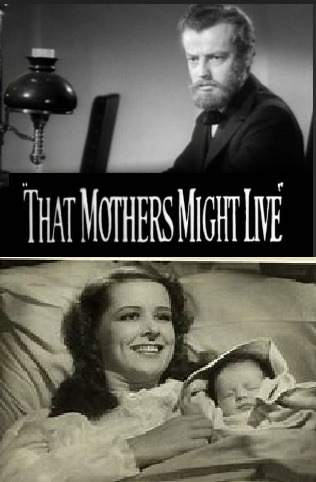
That Mothers Might Live is a 1938 American short drama film directed by Fred Zinnemann. In 1939, at the 11th Academy Awards, it won an Oscar for Best Short Subject (One-Reel).
The short is a brief account of Hungarian physician Ignaz Semmelweis and his discovery of the need for cleanliness in 19th-century maternity wards, thereby significantly decreasing maternal mortality, and of his struggle to gain acceptance of his idea. Although Semmelweis ultimately failed in his lifetime, later scientific luminaries advanced his work in spirit like microbiologistLouis Pasteur, who provided a scientific theoretical explanation of Semmelweis' observations by helping develop the germ theory of disease, and Dr. Joseph Lister, who revolutionized medicine by putting Pasteur's research to practical use. 11th Academy Awards - Wikipedia
youtube
link https://youtu.be/PlIYg6ApCx0 That mothers might live - Ignaz Semmelweis y el lavado de manos

youtube
link https://youtu.be/KmE7gVkK14I Bob Hope & Shirley Ross - Thanks for the Memory (1938) "Thanks for the Memory" (1938) is a popular song, with music composed by Ralph Rainger and lyrics by Leo Robin. It was introduced in the 1938 film The Big Broadcast of 1938 by Bob Hope and Shirley Ross, and recorded by Shep Fields and His Orchestra featuring John Serry Sr. on accordion and vocals by Bob Goday.

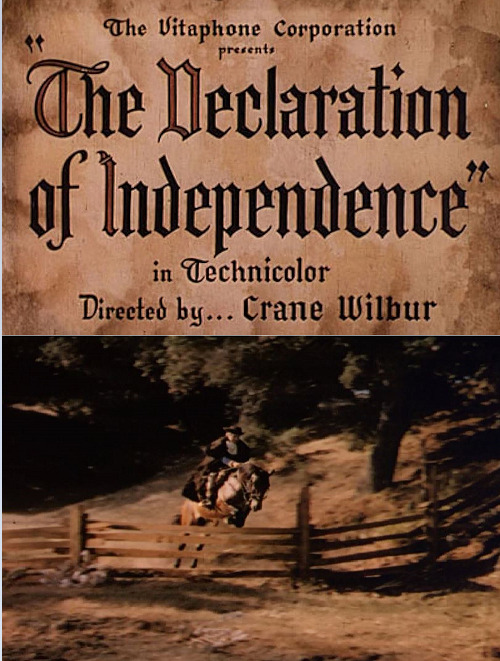
Declaration of Independence is a 1938 American short drama film directed by Crane Wilbur. It won an Academy Award at the 11th Academy Awards in 1939 for Best Short Subject (Two-Reel), and has been credited as being one of the few films relating to the American Revolution to win this award.
Declaration of Independence was part of Warner Bros.'s Old Glory series, which consisted of several short films that covered American history. Declaration of Independence (film) - Wikipedia
youtube
link https://youtu.be/lztj9eINZgE

youtube
link https://youtu.be/Ni6vV9heJhM Alexander's Ragtime Band


youtube
link https://youtu.be/uT6dLPfSCL8 The Adventures Of Robin Hood -Soundtrack Suite (Erich Wolfgang Korngold)

Ferdinand the Bull is a 1938 American stand-alone animated short produced by Walt Disney Productions and released on November 25, 1938, by RKO Radio Pictures. It was directed by Dick Rickard and based on the 1936 book The Story of Ferdinand by Munro Leaf. The music was by Albert Hay Malotte, most known for his setting of The Lord's Prayer, commonly sung at weddings. Ferdinand the Bull (film) - Wikipedia
youtube
link https://youtu.be/pIY-5CzRt0Q
youtube
link https://youtu.be/dQsjAbZDx-4
#1317#OSCAR#11 EDITION#1938#SHORT FILM#That Mothers Might Live#Dir. Fred Zinnemann#Declaration of Independence#Dir. Crane Wilbur.#cartoon#Ferdinand the Bull#Dir. Dick Rickard#music#Bob Hope & Shirley Ross - Thanks for the Memory#Alexander's Ragtime Band#The Adventures Of Robin Hood - Suite (Erich Wolfgang Korngold)#abba - fernando#2025-01-31
9 notes
·
View notes
Text

Justice League: Crisis on Infinite Earths – Part One
Available exclusively on Digital on January 9
4K UHD in limited edition steelbook packaging and Blu-ray arriving on January 23
Parts Two & Three of the Justice League: Crisis on Infinite Earths Trilogy to debut later in 2024
Based on DC’s iconic comic book limited series ‘Crisis on Infinite Earths’ by Marv Wolfman and George Pérez, join DC Super Heroes from across the multiverse in the first of three parts of DC’s new animated film Justice League: Crisis on Infinite Earths – Part One, which marks the beginning of the end to the Tomorrowverse story arc.
Produced by Warner Bros. Animation, DC and Warner Bros. Home Entertainment, the all-new, action-packed DC animated film features some of DC’s most famous Super Heroes from multiple universes including Batman, Superman and Wonder Woman, who come together to stop an impending threat of doom and destruction. The film will be available to purchase exclusively on digital on January 9 and on 4K UHD in limited edition steelbook packaging and Blu-ray on January 23.
Fans of this superhero adventure will also be able to indulge in a range of bonus features including interviews with the filmmakers on how they created a comprehensive universe across seven films.
Justice League: Crisis on Infinite Earths – Part Two and Justice League: Crisis on Infinite Earths – Part Three will be available later in 2024.
Justice League: Crisis on Infinite Earths – Part One features returning popular voice cast members: Emmy winner Darren Criss (The Assassination of Gianni Versace: American Crime Story, Glee) as Superman & Earth-2 Superman, Stana Katic (Castle, Absentia) as Wonder Woman & Superwoman and Jensen Ackles (Supernatural, The Boys, The Winchesters) as Batman/Bruce Wayne. Aside from the returning voice cast, a star-studded ensemble takes shape including Matt Bomer (White Collar, American Horror Story: Hotel) as The Flash/Barry Allen, Meg Donnelly (Legion of Super-Heroes, High School Musical: The Musical: The Series,) as Supergirl & Harbinger, Jimmi Simpson (Star Trek: Prodigy, Westworld) as Green Arrow and Zachary Quinto (Heroes, Star Trek) as Lex Luthor.
Additional cast includes: Jonathan Adams as Monitor, Ike Amadi as J’onn J’onzz/Martian Manhunter, Amazing Man & Ivo, Geoffrey Arend as Psycho Pirate & Hawkman, Zack Callison as Dick Grayson/Robin, Alexandra Daddario as Lois Lane, Alastair Duncan as Alfred, Matt Lanter as Blue Beetle & Ultraman, Ato Essandoh as Mr Terrific, Cynthia Hamidi as Dawnstar, Aldis Hodge as John Stewart/Green Lantern & Power Ring, Erika Ishii as Doctor Light/Dr. Hoshi & Huntress, David Kaye as The Question, Ashleigh LaThrop as Iris West, Liam Mcintyre as Aquaman & Johnny Quick, Nolan North as Hal Jordan, Amazo & Homeless Man, Lou Diamond Phillips as The Spectre & Owlman, Keesha Sharp as Vixen and Harry Shum Jr. as Brainiac 5.
youtube
SPECIAL FEATURES INCLUDE:
Physical and Digital
Crisis Prime(r): The filmmakers reveal in detail their intricate plan to create a comprehensive animated universe across seven films, concluding with the events of the three-part adaptation Justice League Crisis on Infinite Earths.
The Selfless Speedster: Explore The Flash’s legendary role in the “Crisis on Infinite Earths” comic series, the creative process that brought him to life in the animated adaptation, and the vocal performance behind his heroic and romantic story.
Digital Only
Silent Treatment – Film Clip fromJustice League Crisis on Infinite Earths – Part Two
Preorder now at Amazon.

47 notes
·
View notes
Text
I think about Water 7/Enies Lobby
Especially what Suma was doing during that time while the crew was scampering about.
Suma was with Usopp when Franky gets Franknapped. And [ this is a whole piece that Warner & I've worked on that I'm slowly working out to be a big ass piece ] long story short, Suma unintentionally traumatizes everyone in that room by shooting someone point blank in the MOUTH & they don't die.
Anyways.
Enies Lobby.
Everyone is scattered, essentially, trying to figure out where the fuck Robin is. Suma, however, has her own agenda. She leaves the group to start going through building after building, trying to find paperwork. To find anything she can regarding HER family. This is a once in a lifetime chance to find these papers, she's not going to let it go. So while everyone is fighting Cipher Pol-
Suma is raiding these offices in that same building, her heart racing, until she finally finds the files she needed. Grabbing them, stuffing them in her bag and taking off to the roof, where she settles down low and plays sniper. She picks off Marine after Marine while her mind is racing; the files she has is on her family, but not about her parents. No, these filed held maps of Janoshima.
Why did they have maps of Janoshima here? Junpei didn't know Janoshima. These maps were intricate. Detailed. She knew Janoshima. She was raised there. Why did they have maps of Janoshima? It doesn't make sense, nor do the files regarding two women long since dead.
She doesn't have time to question them, though- not with Spandam making a stupid mistake with the buster call. She ends up on the Merry before anyone else, watches as they all file back on, as they escape.
She doesn't get to read those papers until she's sitting in one of the hotel rooms that Iceberg got for them all. And what she reads just doesn't make any sense. Her ancestor was Yukiko. Not- sisters with the surname of Shé-Pí. That's not right. Right?
And she has no one she can ask, here. Robin knows history, yes- but Suma, at this point, still isn't fully trusting of this crew.
Shame that those same maps and documents get left on the Sunny during Sabaody. Shame that those same documents and maps are missing when she returns...
#𝕷𝖎𝖙𝖙𝖑𝖊 𝕾𝖕𝖎𝖉��𝖗: [ Suma ]#𝕻𝖎𝖙 𝖔𝖋 𝖁𝖎𝖕𝖊𝖗𝖘: [ Fujihara Family ]#𝕸𝖆𝖐𝖎𝖓𝖌 𝕻𝖔𝖗𝖙: [ portrayal notes ]#[ and the plot thickens. ]
4 notes
·
View notes
Text
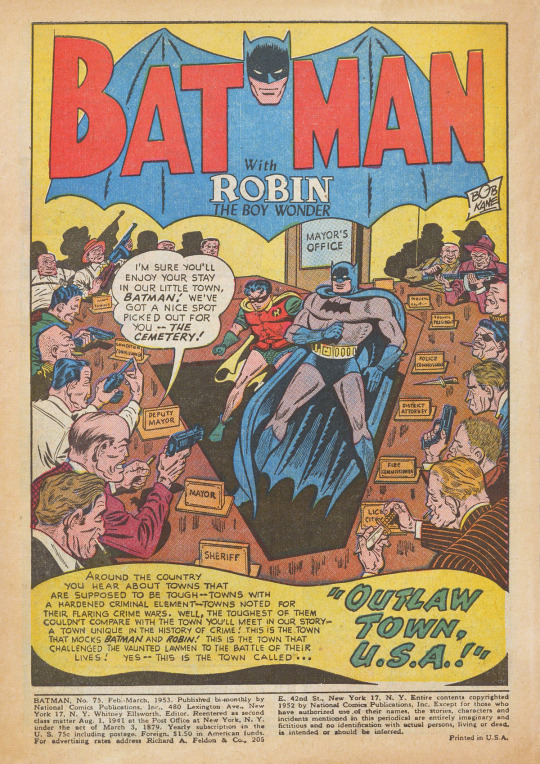
February-March 1953. A recurring motif in Golden Age Batman stories is a specific type of demimonde, where the institutions of respectable society are mirrored in the world of criminals and outlaws. For example, in David Vern Reed's "Outlaw Town, U.S.A.!" (BATMAN #75, above), the old mining town of Silver Vein, "in the mountains near Death Valley," has become a haven for 2,000 gangsters and wanted men, taking advantage of an old law allowing self-governance without state interference. This libertarian environment is not only a hideout, but has developed a booming local economy, full of hotels, casinos, and shops of all kinds. As a narrative caption notes, "Yes, Silver Vein has everything--newspapers, hotels, restaurants, theatres--everything but law!"

In the 1943 story "License for Larceny" (DETECTIVE COMICS #72), by Joe Samachson, J. Spencer Larson, a respectable and seemingly legitimate investment broker, has created a complete miniature ecosystem of law, capital, civil government, taxation, and criminal justice: As "Larry the Judge," he requires other criminals to purchase licenses to commit crimes, taxes them a percentage of their loot, and hires an army of uniformed men to enforce these rules. Those accused of violating the "law" must stand trial, with Larson presiding as judge, and pay a fine — or worse.

The story explains that Larson has established this setup by using funds from his investment clients (which include Bruce Wayne and Dick Grayson) to pay his men, and then using his cut of the crimes committed under his licenses to pay impressive dividends to investors — whom he promptly arranges to have robbed! It's a potent piece of satire: capital as extortion and outright theft, where the only real difference between a gangland enforcer and a cop is the uniform, and the idea of economic mobility is largely a fiction to line the pockets of those in power. Just like the real world, in other words!
While Larson demonstrates no particular remorse, it was fairly common for Golden Age Batman stories, especially in the 1940s, to present characters caught in these demimondes as conflicted or tragic figures. The most familiar (and most extreme) example is Two-Face, first seen in DETECTIVE COMICS #66, who teeters between respectable society and the underworld on the flip of a coin, but there were others as well, like Matthew Thorne, the Crime Doctor (or Crime Surgeon, as he's called in his second appearance), "doctor of medicine...and doctor of crime!!" First seen in DETECTIVE COMICS #77 and probably inspired by the 1938 Warner Bros. film adaptation of Barré Lyndon's THE AMAZING DR. CLITTERHOUSE, starring Edward G. Robinson, Thorne is a respectable surgeon who can't resist the thrill of crime. He establishes a "Crime Clinic" where he offers "prescriptions" to help other crooks with their rackets, occasionally making "house calls" to assist directly in exchange for half the loot — essentially a variation on Larry the Judge's racket.

In his second appearance in BATMAN #18 (above), Thorne has lost his medical license, but he can't entirely ignore his Hippocratic Oath, actually performing surgery to save Robin's life after the Boy Wonder is shot by one of Thorne's men. He's eventually killed by another of his men, whose sick wife Thorne had promised but failed to save. In these stories, the overlap between worlds is not sustainable (except for Batman and Robin), and generally must be resolved by either regeneration or death.
While fighting crime was of course the central preoccupation of the Batman strip, one can also see variations of the demimonde motif in other types of Golden Age Batman stories, in particular the various excursions into the fantastical. Neither the Mars of "Batman, Interplanetary Policeman!" nor the 31st Century of Brane Taylor is an underworld, although they do of course have crime for Batman and Robin to fight, but settings like those have certain similarities with the strip's various criminal demimondes: They are worlds complete unto themselves; they are in some way cloistered; and Batman and Robin's access to them is relatively unique within the narrative. In some cases, even the characters who facilitate that access don't share it; for example, Professor Carter Nichols is not aware of Bruce Wayne and Dick Grayson's secret identities, and, with a few exceptions, isn't privy to the details of the time-travel adventures he sends them on.
In this respect, the principal failing of the weird aliens and bizarre transformations of the early Silver Age Batman stories was not so much that the fantastical aspects were necessarily out of place, but that they were no longer presented as secret, miniature worlds Batman and Robin were privileged to access. Aliens and visitors from the future would just land in downtown Gotham City in broad daylight — visible to everyone, and thus no longer special, or even particularly interesting, just as an ordinary small town is far less interesting than "Outlaw Town, U.S.A.!"
#comics#batman#detective comics#david vern#joe samachson#dick sprang#charles paris#bob kane#jerry robinson#robin#robin the boy wonder#larry the judge#the crime doctor#carter nichols#brane taylor#this theme is not realistic#and no longer made sense when realism became a priority#david vern did some stories along these lines in the '70s#which felt very dated#but it was an important aspect of the appeal of batman#in the golden age#and something to keep in mind when trying to decipher#those stories' ideas about crime and justice
13 notes
·
View notes
Text




Filled out my bingo cards for "stuff I watched in 2024."
My criteria for TV shows to include were shows that I intentionally watched (so nothing that happened to be playing in the same room as me unless I became invested in it) and shows that I watched 3 or more episodes of. The only shows that deviated from these rules were shows like "Dragonhalf" and "Killer Cakes," which only had 2 episodes; however they do count for these purposes because I watched the entire (very short) series.
My criteria for movies to include were films that I intentionally watched (again, nothing that just happened to be playing nearby) and films that I saw all or most of.
📺 TV Shows I watched (at least partially) in 2024:
"6teen"
"Batman: the animated series"
"Batman: the Caped Crusader" (started, didn't finish)
"Be Cool, Scooby-Doo"
"Being Human" the American version (watched most of Season 1 but gave up on it)
"Bewitched"
"Cromartie High School"
"Dr. Pimple Popper" (my current favorite reality show)
"Dragonhalf"
"Frasier" (rewatching random episodes)
"Free! Iwatobi Swim Club," "Eternal Summer," and "Dive to the Future" (I watched all three seasons and had a blast! I never saw the third season before, so that was exciting)
"Gravity Falls"
"Justice League Action"
"Killer Cakes"
"Magnum, P.I." the reboot
"Murder, She Wrote"
"Mutant X" (started, didn't finish)
"Psych"
"Rise of the Teenage Mutant Ninja Turtles"
"Sonic Boom"
"The Edge of Sleep" the Amazon version
"The Feed" (which I started and want to finish)
"The Legend of Vox Machina" (made it through Season 2, have not started Season 3)
"Tokyo Vampire Hotel" (I watched this whole thing... and I couldn't tell you a goddamn thing about it, tbh)
"Scooby-Doo, Where Are You?"
📺 Movies I watched in 2024:
"A Charlie Brown Christmas" Mendelson and Melendez Productions, 1965
"It's Christmastime Again, Charlie Brown" Mendelson and Melendez Productions, 1992
"A Charlie Brown Thanksgiving" Mendelson and Melendez Productions, 1973
"Asteroid City" Universal Pictures, 2023 (which I watched multiple times this year, and has become a new comfort movie)
"Batman Forever" Warner Bros., 1995
"Batman & Robin" Warner Bros., 1997
"Big Top Scooby-Doo" Warner Bros., 2012
"Bottoms" MGM, 2023
"Coraline" Laika, 2009
"Crimson Peak" Legendary Pictures, 2015
"Dave Made a Maze" Dave Made An LLC, 2017
"Donnie Darko" Flower Films, 2001
"Face Your Fears: Thriller Shorts for Adults" Magnetfilm, 2020
"Five Nights at Freddy's" Blumhouse Productions, 2023
"I Love You, Phillip Morris" EuropaCorp, 2009
"Le Voyage Dans La Lune / A Trip To The Moon" Georges Méliès, 1902
"Lisa Frankenstein" MXN Entertainment, 2024
"Little Nemo: Adventures in Slumberland" Tokyo Movie Shinsha, 1989
"Mermaids" Orion Pictures, 1990
"Red, White, & Royal Blue" Amazon Studios, 2023
"Snow White" Golan-Globus Productions, 1987
"Sonic the Hedgehog" Paramount Pictures, 2020
"Sonic the Hedgehog 2" Original Film, 2022
"Teenage Mutant Ninja Turtles: Mutant Mayhem" Nickelodeon Movies, 2023
"The Flash" Warner Bros., 2023
"The Green Knight" A24, 2021
"The Hobbit: An Unexpected Journey" (extended edition) New Line Cinema, 2012
"The Hobbit: the Desolation of Smaug" (extended edition) New Line Cinema, 2013
"The Hobbit: the Battle of the Five Armies" (extended edition) New Line Cinema, 2014
"The Last Unicorn" Rankin/Bass Productions, 1982
"The Lord of the Rings: the Fellowship of the Ring" (extended edition) New Line Cinema, 2001
"The Lord of the Rings: the Two Towers" (extended edition) New Line Cinema, 2002
"The Lord of the Rings: the Return of the King (extended edition) New Line Cinema, 2003
0 notes
Text
Personal Injury Lawyers Atlanta
Our attorneys near me take every prudent step needed to successfully litigate a civil justice case. Kathy McArthur is an ABOTA Board Certified trial lawyer and plaintiff’s personal injury attorney. In June 2024, she started her 45th year as a personal injury lawyer GA, and now leads a team of 7 other civil litigation trial attorneys based in three office locations: Atlanta, Macon, & the Warner Robins area.
Mrs. McArthur has dedicated her entire civil law legal practice to advocating for full compensation for our Firm's vehicular accident litigation, medical negligence cases, trucking accident attorney claims and advocating for other personal injury victims, such as those injured or killed due to negligent security problems at business premises, apartments or hotels.
Named the Super Lawyers “Cover Story” attorney for 2024 in the State of Georgia, this recognition is the pinnacle of a long and successful career. In addition, her firm was named to Best Law Firms in America and Best Lawyers in America many times.
Additional attorneys at the Georgia law firm included Caleb Walker, Jessica Edmonds, Jordan Josey, Lindsey Macon, Quintesha Reynolds, Michael Thompson, and Holly Stephens.
Personal Injury Lawyers Atlanta
1 note
·
View note
Text

Justice League: Crisis on Infinite Earths – Part One (2023) arrives on 4K Ultra HD + Blu-ray 1/23
Heroes from across the multiverse team up in one of the most pivotal DC stories of all time in the animated film Justice League: Crisis on Infinite Earths – Part One
Available exclusively on Digital on January 9
4K UHD in limited edition steelbook packaging and Blu-ray arriving on January 23
Parts Two & Three of the Justice League: Crisis on Infinite Earths Trilogy to debut later in 2024
Based on DC’s iconic comic book limited series ‘Crisis on Infinite Earths’ by Marv Wolfman and George Pérez, join DC Super Heroes from across the multiverse in the first of three parts of DC’s new animated film Justice League: Crisis on Infinite Earths – Part One, which marks the beginning of the end to the Tomorrowverse story arc.
Produced by Warner Bros. Animation, DC and Warner Bros. Home Entertainment, the all-new, action-packed DC animated film features some of DC’s most famous Super Heroes from multiple universes including Batman, Superman and Wonder Woman, who come together to stop an impending threat of doom and destruction. The film will be available to purchase exclusively on digital on January 9 and on 4K UHD in limited edition steelbook packaging and Blu-ray on January 23.
Fans of this superhero adventure will also be able to indulge in a range of bonus features including interviews with the filmmakers on how they created a comprehensive universe across seven films.
Justice League: Crisis on Infinite Earths – Part Two and Justice League: Crisis on Infinite Earths – Part Three will be available later in 2024.
Justice League: Crisis on Infinite Earths – Part One features returning popular voice cast members: Emmy winner Darren Criss (The Assassination of Gianni Versace: American Crime Story, Glee) as Superman & Earth-2 Superman, Stana Katic (Castle, Absentia) as Wonder Woman & Superwoman and Jensen Ackles (Supernatural, The Boys, The Winchesters) as Batman/Bruce Wayne. Aside from the returning voice cast, a star-studded ensemble takes shape including Matt Bomer (White Collar, American Horror Story: Hotel) as The Flash/Barry Allen, Meg Donnelly (Legion of Super-Heroes, High School Musical: The Musical: The Series,) as Supergirl & Harbinger, Jimmi Simpson (Star Trek: Prodigy, Westworld) as Green Arrow and Zachary Quinto (Heroes, Star Trek) as Lex Luthor.
Additional cast includes: Jonathan Adams as Monitor, Ike Amadi as J’onn J’onzz/Martian Manhunter, Amazing Man & Ivo, Geoffrey Arend as Psycho Pirate & Hawkman, Zack Callison as Dick Grayson/Robin, Alexandra Daddario as Lois Lane, Alastair Duncan as Alfred, Matt Lanter as Blue Beetle & Ultraman, Ato Essandoh as Mr Terrific, Cynthia Hamidi as Dawnstar, Aldis Hodge as John Stewart/Green Lantern & Power Ring, Erika Ishii as Doctor Light/Dr. Hoshi & Huntress, David Kaye as The Question, Ashleigh LaThrop as Iris West, Liam Mcintyre as Aquaman & Johnny Quick, Nolan North as Hal Jordan, Amazo & Homeless Man, Lou Diamond Phillips as The Spectre & Owlman, Keesha Sharp as Vixen and Harry Shum Jr. as Brainiac 5.
Justice League Crisis on Infinite Earths – Part One is produced by Jim Krieg and Kimberly S. Moreau and executive produced by Butch Lukic, Sam Register, and Michael Uslan and directed by Jeff Wamester from a script by Jim Krieg. Casting and voice direction is by Wes Gleason.
Justice League Crisis on Infinite Earths – Part One will be available on January 9 to purchase digitally from Amazon Prime Video, AppleTV, Google Play, Vudu and more. On January 23 the film will be available to purchase on 4K Ultra HD in limited edition steelbook packaging and Blu-Ray Discs online and in-store at major retailers. Pre-order your copy now.
SYNOPSIS:
Death is coming. Worse than death: oblivion. Not just for our Earth, but for everyone, everywhere, in every universe! Against this ultimate destruction, the mysterious Monitor has gathered the greatest team of Super Heroes ever assembled. But what can the combined might of Superman, Wonder Woman, Batman, The Flash, Green Lantern and hundreds of Super Heroes from multiple Earths even do to save all of reality from an unstoppable antimatter Armageddon?!
SPECIAL FEATURES INCLUDE:
- Physical and Digital
- Crisis Prime(r): The filmmakers reveal in detail their intricate plan to create a comprehensive animated universe across seven films, concluding with the events of the three-part adaptation Justice League Crisis on Infinite Earths.
- The Selfless Speedster: Explore The Flash’s legendary role in the “Crisis on Infinite Earths” comic series, the creative process that brought him to life in the animated adaptation, and the vocal performance behind his heroic and romantic story.
Digital Only
- Silent Treatment – Film Clip from Justice League Crisis on Infinite Earths – Part Two
PRICING AND FILM INFORMATION
PRODUCT SRP
Digital purchase $19.99
4K Ultra HD Steelbook + Digital Version* $47.99 US
4K Ultra HD Steelbook $54.99 Canada
Blu-ray + Digital Version* $29.98 USA
Blu-ray $39.99 Canada
4K/Blu-ray Languages: English, Latin Spanish, Parisian French
Blu-ray Subtitles: English, Spanish, Dutch, French
Running Time: 92:39
Rated PG for action/violence throughout and brief language
*Digital version not available in Canada
https://mcbastardsmausoleum.blogspot.com/2023/12/release-details-justice-league-crisis.html?m=1
1 note
·
View note
Text
0 notes
Text
Ramada by Wyndham & Suites Warner Robins

Welcome Ramada Hotel & Suites Warner Robins is Located on Interstate 75 exit 146-5.5 miles east on Watson Blvd for memorable stay. Companies located in Warner Robins, GA include Frito Lay, Perdue Farms, Anchor Glass Company, Northrup Grumman, Lockheed Martin and many others. It would be our pleasure to have you stay with us if business with one of these companies brings you to town? If your visit to the area includes a meeting or event, we offer large meeting/banquet space for your convenience. Contact us for complete details. Whatever your reason for coming to town and whatever your need, we’re here to serve you with expert customer service and the high standards you expect from Ramada.
1 note
·
View note
Text
Hotels in Warner Robins GA
Newly Renovated Comfort Inn and Suites Hotel in Warner Robins is less than mile from Robins AFB and Museum of Aviation. Visit www.comfortinnwr.com to book affordable Robins Air Force Base Hotel.

#Per Diem Hotels Warner Robins#Warner Robins GA Hotels#Hotels in Warner Robins Georgia#Hotels near Robins Air Force Base
1 note
·
View note
Text
Ramblings about Lucifer referencing Bones, “Close your eyes.” and shows influencing each other
That was never just a Bones reference being made and the season finale admitted it.
https://www.youtube.com/watch?v=jv_1dJk5yEM
David Boreanaz played the ironically-named Angel on Buffy the Vampire Slayer and Angel: the Series. His character has *so many* parallels with Lucifer (far more than Booth outside of the law enforcement/crime procedural connection).
Angel's spinoff also has noir crime drama aspects mixed with the supernatural starring an immortal protagonist with a dark past and infamously villainous reputation fighting evil as a supernatural private detective in the City of Angels (a city known for its dark underbelly juxtaposed with fame and glamor, broken dreams and chasing eternal youth) and navigating human law (including the LAPD and evil lawyers) while not legally existing.
Angel also fell in love with a blonde human heroine (Buffy Summers) after lifetimes of self-destructive, not-so-heroic behaviors (getting his soul back did *not* make Angel a hero and human Liam was a lecherous drunk with unfulfilled ambitions and father issues) who inspired him to become a better man and make human connections.
AtS made heavy use of sprawling nighttime Downtown L.A. cityscape shots, which Lucifer also shared an abundance of.
During both of their first cases, they failed to save the troubled blonde girl they were trying to help (Tina and Delilah, respectively). They also have a connection inside the LAPD through a blonde cop who also takes their identity secrets pretty badly (Kate Lockley in Angel's case).
Note that Buffy not only screamed (twice, given it repeated during her memory loss in Halloween), but also came after Angel with a crossbow when she thought he'd attacked her mother (it was Darla), so Chloe taking the Devil face reveal (Monster Reveals are iconic old horror imagery) poorly to the point of considering poisoning is par for the course. However, it only took Buffy seven episodes instead of three seasons to get the identity reveal via seeing the horrific second face (arguably also an accident on Angel's part).
They are metaphorically or literally Hell's angels. They also had long stays in Hell or a hell dimension.
Lucifer and Angel are also both Prodigal Sons with long-held grudges against their long-absent fathers (patricide in Liam/Angel(us)'s case) and they're later faced with a situation where they have unexpected, thought-impossible offspring who show up as adults (neither got to raise their miracle child) wanting revenge. Yup, major Connor/Rory parallel there.
Angel is also in a constant struggle with the Powers that Be manipulating his fate and free will (like Lucifer, he's a champion of free will no matter the cost) and making him prophecy's bitch.
Bones famously got jokes about how Booth is Angel getting his Shanshu (made human), since the character is given constant Angel-isms like references to a dark past having killed people (Booth is also named after a historical murderer, in addition to having been a sniper), both being Catholics full of Catholic guilt (note that the Buffyverse is most accurately polytheistic, though Angel does face off against a take on the antichrist--Angel has constant biblical imagery/themes and not just because of vampire iconography), kicking down doors (just not off their entire frames--LOL), turning on a dime and threatening people up against walls, constant wink-wink references to the Buffyverse (familiar casting, references to the Hyperion Hotel, etc...), etc...
The Lucifer finale used the words "Close your eyes." right before Lucifer is sent to Hell. This is literally the BtVS season 2 finale where Buffy kisses Angel and sends him to hell for a century with a stab to the gut (see the season 5 finale, not to mention Lucifer giving up his life for Chloe's à la I Will Remember You).
Note that D.B. Woodside was on BtVS (playing Robin Wood, whose Slayer mother Nikki Wood was killed by Spike). Aimee Garcia was in both episodes of AtS (Birthday--she's older than she looks!) and Bones. See her also playing a cross-wearing religious girl on Supernatural who was slaughtered in a police precinct by Lilith. Kevin Alejandro was also in an episode of Bones.
Tricia Helfer was in an episode of Supernatural playing a ghost who reenacts the night of her death every year. BtVS also had an episode along those lines, but with Buffy and Angelus possessed (not to mention Phantom Dennis!). Lucifer having Dan as a ghost is yet another thing they all have in common (ditto referencing Ghost, Patrick Swayze and/or Unchained Melody--Vincent Schiavelli a.k.a. Ghost's subway ghost was Jenny's uncle Enyos, whom Angelus killed).
Lucifer name-checked Castiel and Supernatural referenced Lucifer using their Lucifer (crime-fighting angel in L.A. made it a double-reference whammy). Supernatural returned the favor again by having Castiel forced to sing in Enochian. Lucifer's reference to his singing voice was already a zing about Misha Collins having to put on that monotone gravel voice and Enochian being far from melodious.
Russell T Davies was quite heavily inspired by the Buffyverse when he revived Doctor Who and spun off Torchwood, so there are absolute tons of Buffy, Angel and Spike respectively in Rose Tyler, the 9th/10th Doctors, Captain Jack Harkness and Captain John Hart (right down to the actor). School Reunion is the episode where the Buffyverse inspiration is most on the nose, complete with Anthony Stewart Head saying "shooty dog thing" in a school setting and a Mayor/Angel-esque speech about the curse of immortality. The Time War gave the Doctor a huge genocide-level guilt complex. Note that the creator of DC comics' version of Lucifer, Neil Gaiman, has also written for Doctor Who and is also the co-creator of Good Omens (the show is brimming with Doctor Who Easter eggs thanks to David Tennant). A barely-recognizable Tom Ellis played Martha Jones' ex-fiancé Tom Milligan during the Year that Never Was, as well.
A lot of shows take inspiration from the Buffyverse and you've probably seen some of them. It isn't just the copycat vampire romance stories either.
Angel's forerunners in turn were a mix of guilt-stricken, rat-eating Louis de Pointe du Lac (his Jekyll/Hyde-esque alter-ego Angelus is closer to the pre-retcon, fully-evil Lestat de Lioncourt, who got woobified into an antihero rocker not unlike Spike--the entire Fanged Four mirror Anne Rice's character lineup), sword-wielding, immortality trope-influencers Connor/Duncan MacLeod of Highlander fighting for the Prize of humanity (akin to Pinocchio becoming a "real boy"--see also Barnabas Collins of Dark Shadows, though he was before vampires became antihero superheroes, not just sympathetic antivillains) and Nick Knight of Forever Knight (vampire detective).
Additionally, Tom Welling was famously the longest-serving Clark Kent of them all (Smallville) on the old WB (there's that DC comics connection, too), so it's not just a Fox shows thing (though Fox, not just Warner Brothers, did indeed own the Buffyverse). One of the least-known things about Clark is that he also has an immortality problem where he wouldn't age parallel to Lois (they wouldn't be able to have kids either) without a workaround. The Kryptonite line directed at Cain/Pierce by Lucifer was quite on the nose! Lucifer and Smallville sort of crossed over even further in Crisis on Infinite Earths, so Tom is canonically the face of both Clark and Cain in parallel universes of the DC multiverse.
Supernatural had quite recently had their own takes on Cain (played by Timothy Omundson, who also played God Johnson) and the Mark of Cain when Lucifer did it. Dan's killer Le Mec was, of course, Rob Benedict, who was God a.k.a. Chuck Shurley, the ultimate villain of Supernatural. Richard Speight, Jr., who was archangel Gabriel/Loki the Trickster, directed a lot of Lucifer's later episodes in addition to being a prolific Supernatural director.
Supernatural and Lucifer use the exact same font for their titles (Supernatural Knight).
The X-Files (which Supernatural referenced constantly) and Supernatural also had stories about nephilim (see the apocryphal Book of Enoch). Lucifer ultimately had two nephilim (forbidden interspecies offspring of angels and humans), even if not saying so as a known concept. Connor can also be compared to the vampire equivalent of being something like a dhampir, though he's not quite that (mostly-but-not-quite-human offspring of two vampires instead of a human/vampire hybrid--see Blade for an actual dhampir). Supernatural has also covered the even rarer cambion species (human/demon hybrid).
#deckerstar#bangel#angel#lucifer#lucifer morningstar#buffy the vampire slayer#angel: the series#bones#buffy summers#chloe decker#angelus#seeley booth#david boreanaz#tom ellis#connor angel#aurora morningstar#castiel#supernatural#smallville#clark kent#the x-files#doctor who#russell t davies#neil gaiman#btvs#ats#highlander#anne rice#ghost#tom welling
27 notes
·
View notes
Text
“It’s still hard:” Asian Americans Paving the Way in Hollywood By Jessica Pickens

The 2018 film CRAZY RICH ASIANS was a success in many areas. Based on the best-selling novel by Kevin Kwan, the film became the highest-grossing romantic comedy in 10 years. An August 2018 article in Time Magazine noted that the film would “change Hollywood.” CRAZY RICH ASIANS was the first film since THE JOY LUCK CLUB (’93) to have an all-Asian American cast or an Asian American lead role. Nearly 60 years before, the all Asian American cast of FLOWER DRUM SONG (‘61) also hoped they were changing the way Asians were cast in Hollywood.
Since the silent era of films, Asian American actors have struggled to find quality roles and respect in Hollywood. Some, actors like Sessue Hayakawa and Anna May Wong, were frequently cast as vamps or villains — which in return put them in poor favor with Japanese and Chinese communities of their time. Miscegenation laws kept Asian American actors from having a romantic leading role with a white actor. In turn, Asians lost roles to white actors in yellowface, from Austrian actress Luise Rainer in THE GOOD EARTH (’37) to English actor Alec Guinness in A MAJORITY OF ONE (’61).
These actors helped fight and pave the way for the success of CRAZY RICH ASIANS:
Sessue Hayakawa

Today, actor Sessue Hayakawa is best recognized for his roles in THE BRIDGE ON THE RIVER KWAI (’57) and as the pirate in Walt Disney’s SWISS FAMILY ROBINSON (’60). But from 1915 to the early 1920s, Japan-born Hayakawa was one of the top silver screen idols of the silent era in the United States and Europe. He was as famous and recognizable as Charlie Chaplin or Douglas Fairbanks, according to his biographer Daisuke Miyao in the book Sessue Hayakawa: Silent Cinema and Transnational Stardom.
Fame followed Hayakawa after playing the lead in Cecil B. DeMille’s THE CHEAT (’15), in which he gives a financial loan to a wealthy woman (Fannie Ward). When she tries to back out of their bargain, he won’t take money as payment, but sexual favors. His character also brands Ward to signify that he owns her. THE CHEAT brought Hayakawa success, but it also brought typecasting. His resulting characters were usually dangerous, forbidden lovers or sexy villains. Hayakawa was criticized by the Japanese-American community for his roles. The Los Angeles-based Japanese American newspaper Rafu Shimpo said THE CHEAT “distorted the truth of Japanese people” depicting them as dangerously evil and would cause anti-Japanese movements.
Hayakawa eventually grew tired of the stereotypical roles he was cast in. In 1922, Hayakawa went to Europe where he performed in England and France. He stayed in Europe until after World War II and returned to Hollywood in 1949. Hayakawa was recognized for his role in THE BRIDGE ON THE RIVER KWAI with an Academy Award nomination for Best Actor in a Supporting Role.
Anna May Wong

She was rejected by China because she was “too American” and rejected in Hollywood because she was “too Chinese.” But Chinese American actress Anna May Wong achieved international fame by the mid-1920s, though she struggled with being stereotyped. Often cast as a vamp, sexual figure, slave or prostitute, the Chinese government said she played roles that demeaned China, and Graham Russell Hodges’ Anna May Wong: From Laundryman's Daughter to Hollywood Legend recalls how the Chinese media and government resented “having their womanhood so represented.”
When Wong campaigned for roles that could potentially change her image, like O-Lan in THE GOOD EARTH, she lost out to a white actor playing yellowface. In fact, the Chinese government worked against Wong being cast in THE GOOD EARTH. Hodges states how General Tu, MGM’s Chinese government advisor, told MGM that her reputation was bad in China and whenever she appeared in a film, newspapers printed that “Anna May loses face in China again.”
When white actor Paul Muni was cast as the male lead of THE GOOD EARTH, Wong knew she had missed her opportunity because of miscegenation laws. Wong supported China during World War II through the Red Cross, USO and China Relief efforts. She also wrote articles in China’s support and created a cookbook of traditional Chinese dishes. On the first anniversary of the Pearl Harbor attacks, she was sworn in as an air raid warden, according to Hodge’s book.
In 1943, the First Lady of the Republic of China, Madame Chiang Kai-shek, visited Hollywood. She gave a speech at the Hollywood Bowl and a luncheon was held. Madame Chiang Kai-shek was flanked by actresses like Marlene Dietrich and Loretta Young, but noticeably not Wong. Madame Chiang had specifically requested for Wong to be excluded from the events. Anna May Wong continued to act sporadically and died just before she was to co-star in the all Asian American cast of THE FLOWER DRUM SONG.
Keye Luke
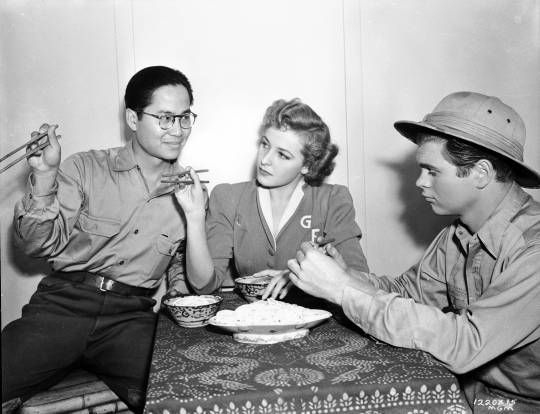
Chinese actor Keye Luke started in films in the 1930s, usually playing a mild-mannered, polite and intelligent young adult Asian male. Often, Luke played young physicians, like in THE PAINTED VEIL (’34), MAD LOVE (’35) and the Dr. Kildare and Dr. Gillespie film series. Luke became best known for his role in the 1930s as Lee Chan, the No. 1 son of detective Charlie Chan, who was played by white actor Warner Oland. The film series has since been criticized for perpetuating Asian stereotypes and having a white actor in the lead role, but Luke defended the films.
“How can they be criticized when the character was a hero,” Luke said in a 1986 Los Angeles Times interview. “People respected him. Police departments consulted with him and called on him to help them.” However, despite this, Luke and other Asians faced racism in Hollywood. Luke said in the 1930s that Los Angeles was “segregated, but not formally.” He was only hired when they needed a “Chinaman.”
“One never saw blacks on Wilshire Boulevard. Parts of the city I avoided–all white areas like Beverly Hills. Even after working with somebody like a big Caucasian actor, I’d be ignored if we met on the street. Asians were invisible, you see. We knew our place: One step back. That’s why the Charlie Chan films were so important. They deflated a lot of the current racial myths. But even the Chan films had rules. Charlie never touched a white woman except as a handshake. I’d never have a white girlfriend, not that I wanted one in pictures,” Luke said in an interview published in Conversations with Classic Film Stars: Interviews from Hollywood's Golden Era by James Bawden and Ron Miller.
After World War II, Luke found roles were harder to find, and many of his roles were uncredited. By the 1960s, more Asian actors were on the screen. In his interview with Miller, Luke joked that before the 1960s he and Korean actor Philip Ahn “divided the work.”
Philip Ahn
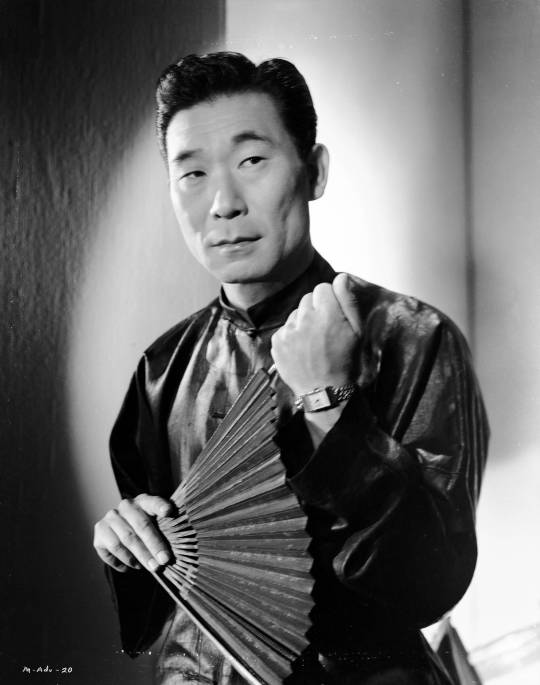
Philip Ahn was a Korean American actor who only played a Korean character once on film. In Hye Seung Chung’s Hollywood Asian: Philip Ahn and the Politics of Cross-Ethnic Performance, he details how before World War II, Ahn was promoted as a Chinese actor and often nicknamed the “Oriental Clark Gable.” During World War II, however, Hollywood shifted its publicity and focused on Ahn’s Korean ancestry. The publicity articles discussed Ahn’s father, Ahn Changho, who was an activist against the Japanese government. Ahn was also promoted as “the man we love to hate” and the “leering yellow monster.”
During the war, Ahn was frequently cast as a Japanese soldier in the 1940s, something he later said that he didn’t mind, as he felt he was contributing to his late father's legacy. Despite these characters not reflecting Ahn’s personality, Chung recalls how Ahn received hate mail from audiences who confused his onscreen characters for real life. In the 1953 Korean War film BATTLE CIRCUS, Ahn and his brother Ralph both played North Korean prisoners. Ahn said while he played many nationalities, this was the only time he played a Korean character, according to his 1978 The New York Times obituary.
Miyoshi Umeki

Japan-born Miyoshi Umeki was the first Asian to win an Academy Award for a performance. Umeki won Best Supporting Actress for her first Hollywood film, SAYONARA (’57). Though Umeki was the first Asian to win an Academy Award, this “first” isn’t often discussed. Despite the accolade, Umeki was still stereotyped in Hollywood. Her characters were generally demure, humble, delicate and subservient. Umeki’s characters spoke in broken English with a sweet smile.
Her son Michael Hood later asked her why she agreed to play these characters. “Her answer was very simple: ‘I didn’t like doing it, but when someone pays you to do a job, you do the job, and you do your best,’” Hood said in a 2018 Entertainment Weekly article. Umeki later threw away her Academy Award statue, according to Hood. As of 2020, Umeki is the only Asian female to win an Academy Award.
Nancy Kwan
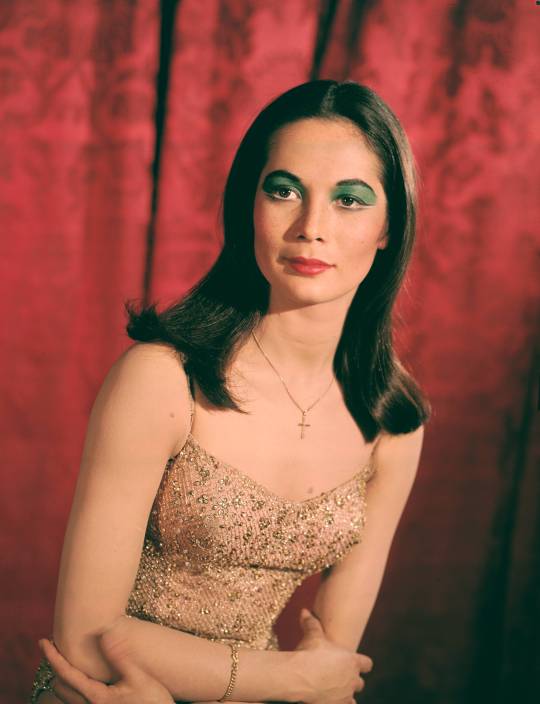
Hong Kong-born actress Nancy Kwan burst on to the film scene in 1960. She was cast as the lead in THE WORLD OF SUZIE WONG (’60) alongside one of Hollywood’s top actors, William Holden. Kwan was then cast in the all -Asian American cast of the Rodgers and Hammerstein film version of FLOWER DRUM SONG. With a strong start in films, a successful Hollywood career seemed likely for Kwan, but the roles weren’t there. William Holden told her, “You can do a big film and be very successful but in order to sustain a career, you have to have roles written for you,” Kwan shared in a 2018 NBC interview. Kwan was more successful than her predecessors, however, as Asians were starting to be cast rather than white actors in yellowface. Kwan was also cast in roles where she had white romantic leading men, like HONEYMOON HOTEL (’64) and THE WILD AFFAIR (’65). But Hollywood still didn’t know what to do with Kwan. She was cast in “exotic” roles like in the Walt Disney film LT. ROBIN CRUSOE, U.S.N. (’66) as an island girl. Kwan was offered a role in the film THE JOY LUCK CLUB, but she revealed in a 2018 interview at the TCM Classic Film Festival that she declined it because of a line criticizing SUZIE WONG. While she mentioned in a 1990 Los Angeles Times interview that “There are now many, many Asian actresses — but not many roles,” 18 years later she noted that the film industry had changed, but not enough. “There are more leading roles and not just small roles, but it’s still hard.”
#Asian American#Asians in Hollywood#Sessue Hayakawa#Anna May Wong#Philip Ahn#Miyoshi Umek#Keye Luke#Nancy Kwan#TCM#Turner Classic Movies#Jessica Pickens#classic hollywood
715 notes
·
View notes
Photo

2020 Reading Challenge Report
I really liked it last year when I made a spread in my journal with my best of books for 2019. So here’s my best of for 2020.
I was WAY surprised that all my favorite books this year were non-fiction. That doesn't mean I didn’t read any good fiction this year, I definitely did. But the truly outstanding, five star books were all non-fiction. This is super weird for me because I never used to read non-fiction unless it was for school. But last year I made a deal with myself that I should have a non-fiction book as at least one of my books-in-progress at all times. I continued that rule this year and wow have I read some great stuff as a result.
Metrics:
Total books read in 2020: 87
If you remove all the books I read with kids, that’s 64. If you remove the books I read with kids and also graphic novels (which—despite being books, goddamn it—admittedly take a lot less time to read), I read 45 books this year. I refuse to remove the audiobooks because that’s hella insulting. Audiobooks are books.
One thing I noticed this year is that before I counted, I was under the impression that I had read a lot of books by Black authors this year, but I hadn't. In fact, it was far fewer than last year. I think part of what was internally confusing was that because two of my books were Caste and The Warmth of Other Suns, both substantial (in the thinking sense and the length sense), at any given time this year, I was reading at least one book by a Black author. So that skewed my thinking. Still, fewer than 10% Black authors is a poor metric.
Another thing I noticed was that cancelled plans for 10 months also means cancelled car trips (yay!) and cancelled audiobook listenings (boo!) So that cut into my total a bit, not listening to books as much with the kids. But I'm looking forward to lots more reading in the new year! Including finishing a bunch of books the kids and I are reading for school and tons of stuff for work. Because I like to have things going on every burner, there are 10 books in progress at the moment, about half of them for school.
In case you might be interested, here’s my list, favorites in bold:
Non-Fiction (23)
Figuring, Maria Popova
Know My Name, Chanel Miller
*The Fire Never Goes Out, Noelle Stevenson
With Purpose and Principle, Edward Frost
Caste, Isabel Wilkerson
The Warmth of Other Suns, Isabel Wilkerson
Widening the Circle of Concern, COIC, UUA
Brief Histories of Everyday Objects, Andy Warner
Breaking and Blessing, Sean Parker Dennison
This Book is Anti-Racist, Tiffany Jewell & Aurelia Durand
The Library Book, Susan Orlean
My Autobiography of Carson McCullers, Jenn Shapland
Furious Hours, Casey Cep
Scrappy Little Nobody, Anna Kendrick
I'll Be Gone in the Dark, Michelle McNamara
Catch and Kill, Ronan Farrow
*Laika, Nick Abadzis
*First Year Out: A Transition Story, Sabrina Symington
* Honor Girl: A Graphic Memoir, Maggie Thrash
*Drowned City: Hurricane Katrina and New Orleans, Don Brown
Say Nothing: A True Story of Murder and Memory in Northern Ireland, Patrick Radden Keefe
*A Quick and Easy Guide to Queer & Trans Identities, Mady G., J.R. Zuckerberg
*Wait, What?: A Comic Book Guide to Relationships, Bodies, and Growing Up, Heather Corinna, Isabella Rotman
Fiction (40)
*Heartstopper, vol 1&2, Alice Oseman
When the Tripods Came, John Christopher
Empty World, John Christopher
You Should See Me in a Crown, Leah Johnson
The Pull of the Stars, Emma Donoghue
Pachinko, Min Jin Lee
My Year of Rest and Relaxation, Ottessa Moshfegh
Girl, Woman, Other, Bernadine Evaristo
*This One Summer, Mariko Tamaki
*Laura Dean Keeps Breaking Up with Me, Mariko Tamaki, Rosemary Valero-O'Connell
To Night Owl, From Dogfish, Holly Goldberg Sloan and Meg Wolitzer
* Almost American Girl, Robin Ha
Upright Women Wanted, Sarah Gailey
When We Were Magic, Sarah Gailey
Magic for Liars, Sarah Gailey
The Ballad of Songbirds and Snakes, Suzanne Collins
The Care and Feeding of Waspish Widows, Olivia Waite
The Dreamers, Karen Thompson Walker
The Water Dancer, Ta-Nehisi Coates
Less, Andrew Sean Greer
*Drama, Raina Telgemeier
The Glass Hotel, Emily St. John Mandel
Severance, Ling Ma
Once, Morris Gleitzman
Then, Morris Gleitzman
Reflections in a Golden Eye, Carson McCullers
The Future of Another Timeline, Annalee Newitz
Royal Rebel, Jenny Frame
*Sidekicks, Dan Santat
The Book of Dust, Philip Pullman
The Miraculous Journey of Edward Tulane, Kate DiCamillo
*Snapdragon, Kat Leyh
Catfishing on Catnet, Naomi Kritzer
*Princess Princess Ever After, Katie O'Neill
*The Prince and the Dressmaker, Jen Wang
*All Summer Long, Hope Larson
Children of Virtue and Vengence, Tomi Adeyemi
On the Edge of Gone, Corinne Duyvis
*Kiss Number 8, Colleen A.F. Venable, Ellen T. Crenshaw
*Queen of the Sea, Dylan Meconis
Read With the Kids (23)
Sentence Island, Michael Clay Thompson (NF)
*Hereville: How Minka Got Her Sword, Barry Deutsch
Hatchet, Gary Paulson
The Dreamer, Pam Muñoz Ryan, Peter Sis
Before Columbus, Charles Mann (NF)
Tristan Strong Punches a Hole in the Sky, Kwame Mbalia
In the Footsteps of Crazy Horse, Joseph M. Marshall III
It's a Feudal, Feudal World, Stephen Shapiro and Ross Kinnaird (NF)
Pedro's Journal, Pam Conrad
A Long Way from Chicago, Richard Peck
Sees Behind Trees, Michael Dorris
The Shakespeare Stealer, Gary Blackwood
The Giver, Lois Lowry (reread for me)
The Saturdays, Elizabeth Enright (reread)
Timmy Failure: Mistakes were Made, Stephan Pastis
Jennifer, Hecate, Macbeth, William McKinley, and Me, Elizabeth, E.L. Konigsburg
Sideways Stories from Wayside School, Louis Sachar
Wayside School is Falling Down, Louis Sachar
A Little History of Philosophy, Nigel Warburton (NF)
The Parker Inheritance, Varian Johnson
How to Think Like a Cat, Stephanie Garnier (NF)
Book Scavenger, Jennifer Chambliss Bertman
The Third Mushroom, Jennifer L. Holm
*=graphic novel
I read 87 books this year, by 80 authors
Authors of color = 14 Black authors = 7 Women or non-cis-gender men authors = 53 Graphic novels = 22 Non-fiction = 28 Queer characters = 28 Audiobooks = 26
10 notes
·
View notes
Text
THE DARK CORNER
November 10, 1947

Synopsis ~ A former San Francisco private eye, just in back New York after two years in prison (the victim of a frame-up), finds himself a target for another send-up and murder.
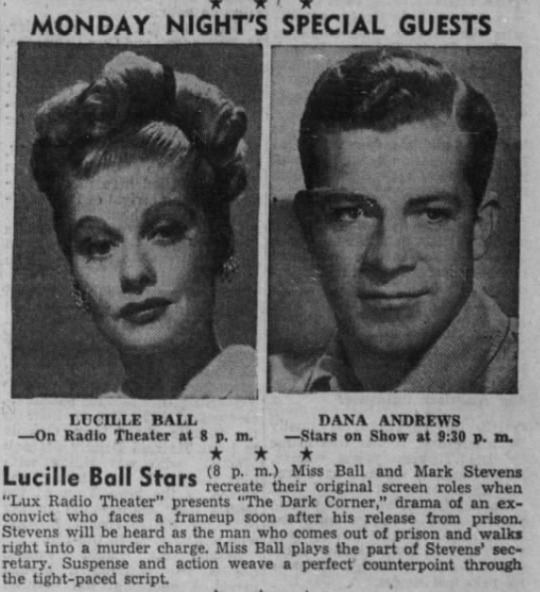
Directed by Fred MacKaye with musical direction by Louis Silvers and sound effects by Charlie Forsyth
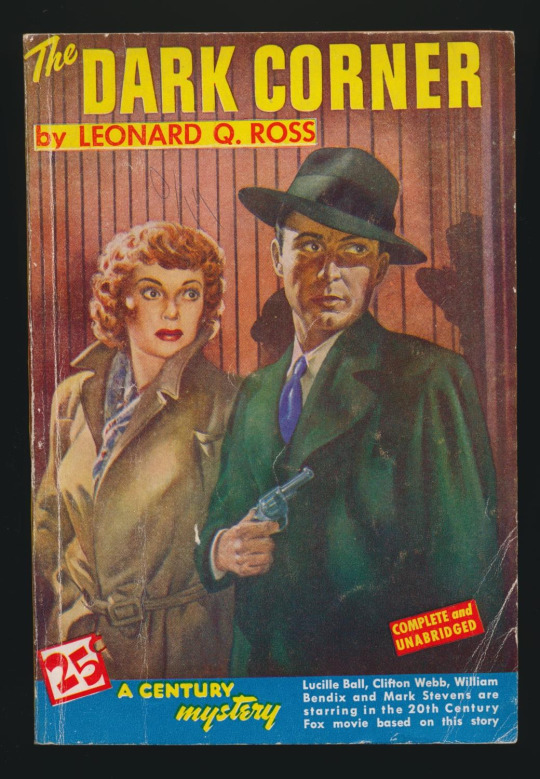
Adapted for radio by Sanford Barnett from the screenplay by Jay Dratler and Bernard Schoenfeld based on the book by Leo Rosten.
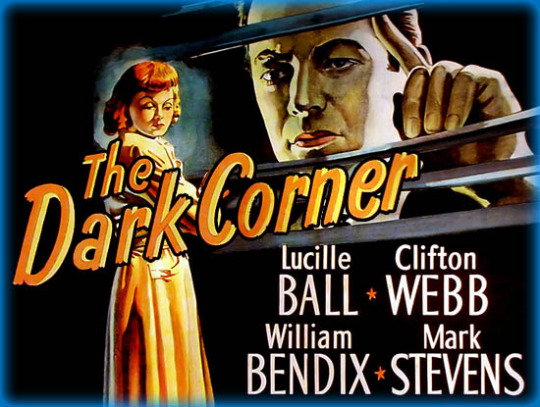
It was based on the 20th Century Fox motion picture of the same name released on May 8, 1946.
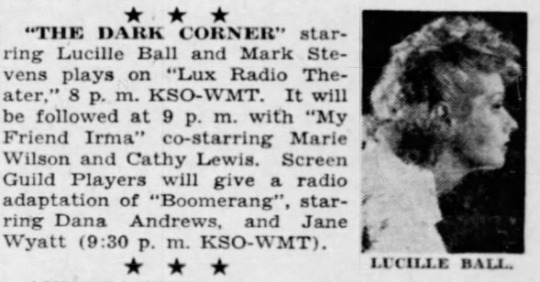
In later years, Lucille Ball was vocal about hating the experience of shooting The Dark Corner. Director Henry Hathaway's bullying reduced Ball to stuttering on set, at which point Hathaway accused her of being inebriated. At the time, Lucille Ball was suing to get out of her contract with MGM. As a result, MGM loaned her to Fox for this picture, which included a significant pay cut.
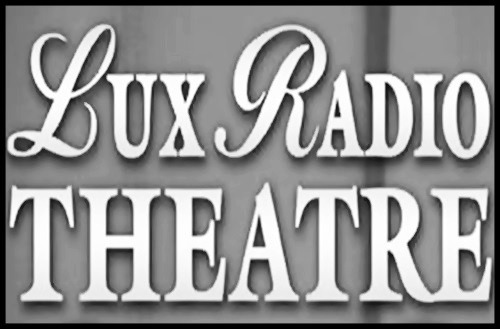
Lux Radio Theatre (1935-55) was a radio anthology series that adapted Broadway plays during its first two seasons before it began adapting films (”Lux Presents Hollywood”). These hour-long radio programs were performed live before studio audiences in Los Angeles. The series became the most popular dramatic anthology series on radio, broadcast for more than 20 years and continued on television as the Lux Video Theatre through most of the 1950s. The primary sponsor of the show was Unilever through its Lux Soap brand.
CAST

Lucille Ball (Kathleen Stewart) was born on August 6, 1911 in Jamestown, New York. She began her screen career in 1933 and was known in Hollywood as ‘Queen of the B’s’ due to her many appearances in ‘B’ movies. “My Favorite Husband” eventually led to the creation of “I Love Lucy,” a television situation comedy in which she co-starred with her real-life husband, Latin bandleader Desi Arnaz. The program was phenomenally successful, allowing the couple to purchase what was once RKO Studios, re-naming it Desilu. When the show ended in 1960 (in an hour-long format known as “The Lucy-Desi Comedy Hour”) so did Lucy and Desi’s marriage. In 1962, hoping to keep Desilu financially solvent, Lucy returned to the sitcom format with “The Lucy Show,” which lasted six seasons. She followed that with a similar sitcom “Here’s Lucy” co-starring with her real-life children, Lucie and Desi Jr., as well as Gale Gordon, who had joined the cast of “The Lucy Show” during season two. Before her death in 1989, Lucy made one more attempt at a sitcom with “Life With Lucy,” also with Gordon.
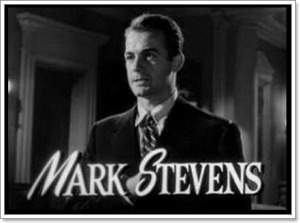
Mark Stevens (Bradford Galt) reprises his role from the film version of The Dark Corner (1946). He became a contract player for Warners at $100 a week in 1943 but they darkened and straightened his curly ginger-colored hair and covered his freckles. At first he was billed as Stephen Richards, he later changed it to Mark Stevens at the suggestion of Darryl F. Zanuck when he switched to 20th Century-Fox. He died in 1994 at age 77.

Joseph Kearns (Ralph Wickett) appeared on “I Love Lucy” as the psychiatrist in “The Kleptomaniac” (ILL S1;E27) and later played the theatre manager in “Lucy’s Night in Town” (S6;E22). His most famous role was as Mr. Wilson on TV’s “Dennis the Menace” (1959). When he passed away during the show’s final season, Lucy regular Gale Gordon took over for him, playing his brother.
In the film, the character was named Hardy Cathcart and was played by Clifton Webb.
Norma Jean Nilsson (Little Girl at the Boarding House) was a child actress who left Hollywood at age 19 after appearing in 16 films and television shows.
In the film, the character carries a slide whistle, which is not used here. She was played by Colleen Alpaugh.
Wally Maher (Fred Foss aka Stauffer) was born on August 4, 1908 in Cincinnati, Ohio. He was known for Mystery Street (1950), The Reformer and the Redhead (1950) and Hollywood Hotel (1937). He was married to Molly Bruno. He died on December 27, 1951.
In the feature film, the role was played by William Bendix, who would go on to fame as the title character in TV’s “The Life of Riley.”
Dan O'Herlihy (Anthony Jardine) was an Irish-born actor nominated for an Oscar in 1954 for Robinson Crusoe. In 1960 he made an appearance on Desilu’s “The Untouchables.” He was in two of the RoboCop movies. He died in 2005 at age 85.
In the feature film, the role was played by German-born actor Kurt Krueger.
Fay Baker (Mari Wickett) was born on January 31, 1917 in New York City as Fanita Baker Schwager. She was known for Notorious (1946), The House on Telegraph Hill (1951) and Deadline - U.S.A. (1952). She died on December 8, 1987.
In the feature film, the role was taken by Cathy Downs, making her first credited screen appearance.
ENSEMBLE
Trude Marson was seen in uncredited roles in four films from 1937 to 1947.
Noreen Gammill started her screen career as the voice of Catty the Elephant in Disney’s Dumbo (1941). She made two background appearances on “The Andy Griffith Show” (1963 and 1964), filmed on the Desilu backlot.
William Johnstone is probably best remembered as Judge Lowell on the long-running daytime drama “As The World Turns”. Prior to that he worked extensively in radio and took over the role of Lamont Cranston on "The Shadow" playing opposite Agnes Moorehead when Orson Welles left the series.
Janet Scott was a regular background voice on “Lux Radio Theatre” with dozens of episodes to her credit from 1937 to 1955.
Lois Corbett was married to Don Wilson of “The Jack Benny Program” and as such did more than a dozen episodes of the television shows with him from 1954 to 1964.
Edward Marr was seen in The Affairs of Annabel with Lucille Ball in 1938. He was also in two Bob Hope TV specials with Hope and Ball in 1966 and 1970.
Stanley Farrar was seen on “I Love Lucy” in “Home Movies” (ILL S3;E20) and “Staten Island Ferry” (ILL S5;E12). He on “The Lucy Show” in “Lucy and Arthur Godfrey” (TLS S3;E23) and “Lucy Meets Danny Kaye” (TLS S3;E15).
Herb Butterfield was born on October 28, 1895 in Providence, Rhode Island. He was known for The Halls of Ivy (1954), The House on Telegraph Hill (1951) and Shield for Murder (1954). On radio, he portrayed the Commissioner on NBC 's "Dangerous Assignment" (1949-53) and Clarence Wellman on "The Halls of Ivy" (1950-52). He died on May 2, 1957
Cliff Clark was seen with Lucille Ball in Her Husband’s Affairs (1947), Miss Grant Takes Richmond (1949), and The Fuller Brush Girl (1950).
OTHERS

William Keighley (Host and Producer) was the director of nearly 40 feature films between 1932 and 1953. His film The Adventures of Robin Hood (1938) was selected for the National Film Registry by the Library of Congress as being culturally significant.
Dorothy Lovett (Commercial Spokeswoman as Libby Collins, Hollywood Reporter) appeared as Meta Bauer on radio’s “The Guiding Light" (1945-47) and as Toni Sherwood in "The Adventures of Rocky Jordan". She did three films with Lucille Ball from 1939 to 1941.
Betty Ann Lynn (Herself, Act Two Intermission Guest) is best known for playing Thelma Lou on “The Andy Griffith Show” (1961 to 1965) which was filmed on the Desilu back lot.
John Milton Kennedy (Announcer) was the announcer of all 35 episodes of “The Loretta Young Show” from 1954 to 1955.
ACT ONE

William Keighley introduces the program, noting that many years earlier, director Fred Kohlmar saw a titian-haired young model who had great possibilities - Lucille Ball. He later had the privilege of presenting her in the film version of The Dark Corner. After a mention of Lux Toilet Soap, the program begins.
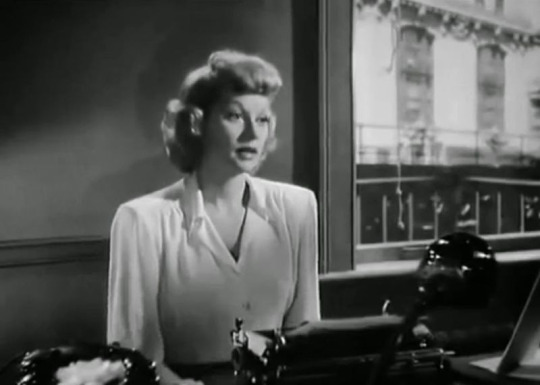
The action opens in a New York City office building on a sultry summer afternoon. Police detective Reeves visits the Offices of Bradford Galt, Private Investigator and speaks to his secretary, Kathleen Stewart.
Galt enters and Reeves wonders why Galt didn’t notify him that he moved offices after his prior unpleasantness. Galt asks Kathleen to have dinner with him. After dinner, Galt asks her to go dancing but she’s wise to his advance. As they walk down the street, they realize that they are being followed.
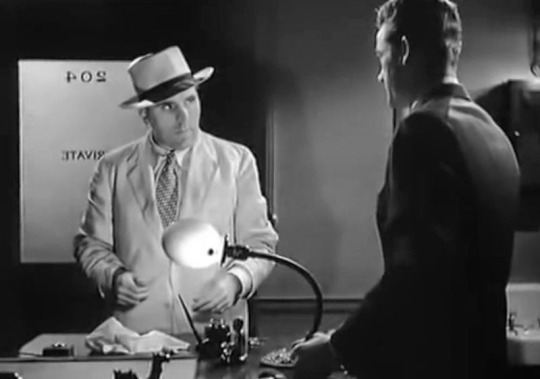
Kathleen takes a cab back to the office, while Galt confronts the pursuer at gunpoint, taking him back to his office for questioning. He says his name is Fred Foss, and that he’s also a private detective. Galt doesn’t believe him and decides to beat the truth out of him.

After some roughing up, Fred discloses that he is being paid to tail Galt by Anthony Jardine. In the tussle, some ink spills on Foss’s white suit. He lets Foss leave. Kathleen was supposed to tail Foss after he left the office, but he tricked her and got away.
Back at his rooming house, Foss uses the hall telephone to call art gallery owner Ralph Wickett, and his ink-stained suit is noticed by a Little Girl neighbor.
At a party for his third wedding anniversary, Wickett hangs up and is greeted by Jardine, a lawyer. Mrs. Lucy Wilding takes Jardine aside pretending to ask legal advice, but it is revealed that he is blackmailing her.
Meanwhile, Galt confides in Kathleen about his past. Jardine is trying to kill Galt because he was a former partner that Galt confronted about his blackmailing female clients. Now Jardine wants to finish the job.
Mari Wickett, Ralph’s wife, is having an affair with Anthony Jardine. She wants to run away with him. At the same time, Galt is headed there to settle the score.
End of Act One

A Lux commercial break takes the form of a story from Libby Collins, Hollywood Reporter. She says she saw Universal’s The Lost Moment starring Robert Cummings and Susan Hayward. Libby says she was on location when they filmed the big fire scene, the biggest fire ever done on a sound stage. She says that she and Susan Hayward washed the soot off their faces with Lux Toilet Soap!
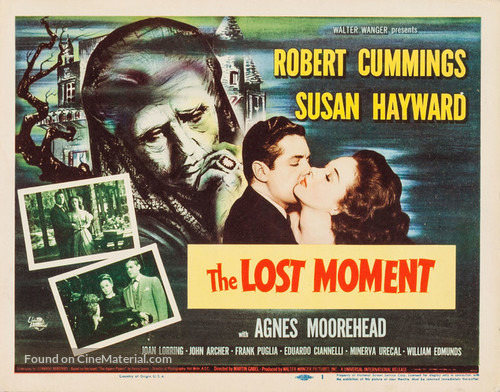
At the time of the broadcast, The Lost Moment was still two weeks from being released. It opened in cinemas on November 27, 1947. The story is set in Italy, so the cast included Edward Ciannelli, who played pizzeria owner Mr. Martinelli in “Visitor from Italy” (ILL S6;E5) and Saverio LoMedico who played the Rome hotel bellboy in “Lucy’s Italian Movie” (ILL S5;E23). The film was not a box office success.
ACT TWO

An hour has past since the end of Act One and Galt is at Jardine’s door. Galt threatens Jardine, who denies tailing him.The two fight while Mari is hiding in the other room. After Galt leaves, she convinces him to run away with her.
At the Gallery, Wickett is visited by Foss. It is clear Wickett is setting up Jardine to take the fall when he has Galt killed. Foss calls Galt to betray Jardine for a price. Galt suggests a one-on-one meeting at his apartment - 904 West 52nd, apartment 307 at 8pm sharp. Wickett will send Jardine to Galt’s apartment at 7:30pm.
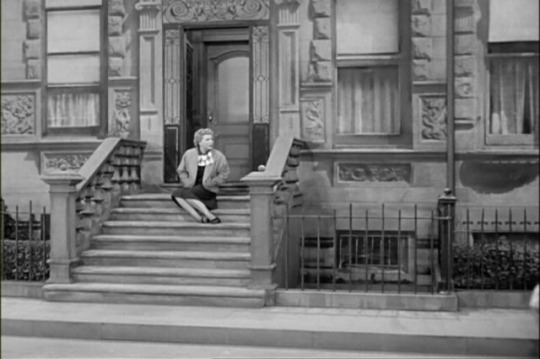
In reality, there is no such address. West 52nd Street in New York City ends at the the 600s block. This is similar to the Ricardo and Mertz apartment building. 623 East 68th Street, which, if real, would be in the East River!
Kathleen and Galt are supposed to meet at the movies, but he doesn’t show so he goes to his apartment at 8:30. Galt opens the door and reveals that Jardine is dead. Galt was ambushed with and knocked out with ether. He woke up to find Jardine’s body bludgeoned by the fireplace poker. Galt realizes he was set up.
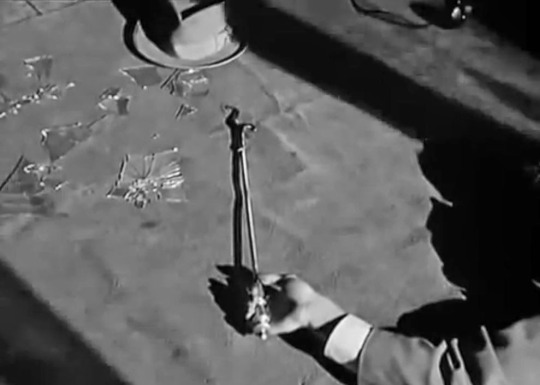
Later, Galt meets Kathleen at her apartment. He couldn’t find Foss and doesn’t know where to look next.
Wickett reminds Mari that they are due at the Kinsglsey’s that night, but she begs off. He strongly hints that he knows that Mari is stepping out on him and looking to run off.
Galt suddenly realizes that Foss would have to have his white suit cleaned, so he is determined to search all the cleaners for the suit and get his address.
Foss phones Wickett, and the Little Girl is there to overhear his conversation. Foss makes a plan to meet Wickett on the 31st floor of the Grant building.
Galt and Kathleen are about to give up on the search for the suit when a cleaner comes through. They get his address and trace Foss to the rooming house where he lives. His name turns out to be Stauffer, not Foss. The landlady reports that he moved out an hour ago and doesn’t know where he went. But the Little Girl does - and spills the beans for a quarter! Galt and Kathleen head for the Grant Building.
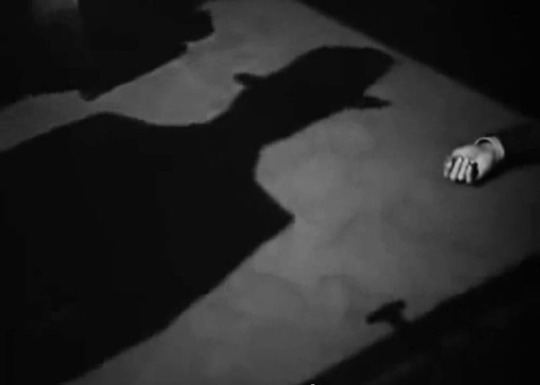
End of Act Two
In the break, Keighley interviews Fox contract player Betty Ann Lynn, who saw filming of Daryl F. Zanuck’s Gentleman’s Agreement starring Gregory Peck and Dorothy McGuire in a “very unusual picture”.

Gentleman’s Agreement premiered on November 11, one day after this broadcast, in both New York City and Chicago. It dealt with anti-Semitism and went on to win three Oscars, including Best Picture. The cast included Lucycom alumni Mike Lally, Shep Houghton, Roy Roberts, and Amzie Strickland in uncredited roles. Betty Ann Lynn says that she also likes to watch the filming of a costume picture like The Foxes of Harrow starring Rex Harrison and Maureen O’Hara, who had 26 costumes made just for her. She notes that O’Hara has a Lux complexion.
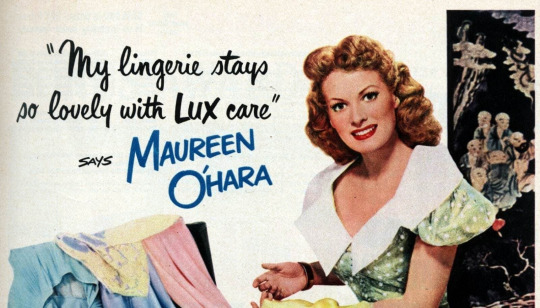
The Foxes of Harrow was released September 13, 1947. "Lux Radio Theater" broadcast a sixty minute radio adaptation of this movie on December 6, 1948, with Maureen O'Hara reprising her movie role. The movie was the screen debut of William Schallert, who did several episodes of “The Lucy Show.” O’Hara and Lucille Ball became lifelong friends after their 1940 film Dance, Girl, Dance. Like Gentleman’s Agreement, The Foxes of Harrow also features Roy Roberts, who went on to play bank president Mr. Cheever on “The Lucy Show.”
ACT THREE
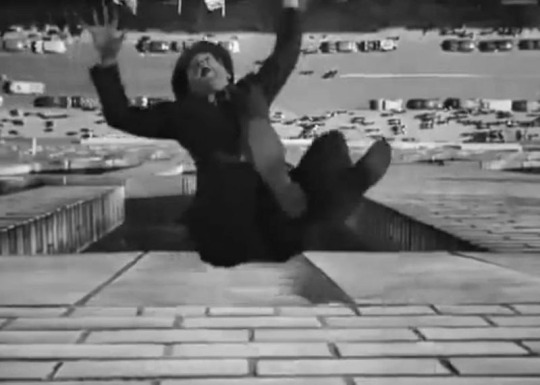
Kathleen and Galt rush to the Grant Building, where Mr. Wickett is about to settle accounts on a remote fire escape. Foss / Stauffer brings proof that Jardine is dead but Wickett throws him from the fire escape to his death.
Galt and Kathleen witness the whole incident from the street, as does the cab driver who was waiting for Foss / Stauffer. Thinking fast, Galt steals the cab which still contains Foss’s luggage. Later, we hear that the bags were only full of clothes. Kathleen urges him to keep thinking. Kathleen suddenly remembers that the Little Girl mentioned galleries. They put the pieces together and all evidence leads them to the Wickett Galleries. Galt heads there and questions the clerk. Under the guise of buying a painting, Galt inquires about meeting Mr. Wickett, and the clerk departs. Mari comes in the side door, and Galt tells her that Anthony Jardine has been murdered. She faints. Wickett comes in and when Galt tells him the truth, Ralph locks him in the gallery vault. Mari has revived and overhears Ralph’s threats, holding a gun on him. She shoots her husband dead.
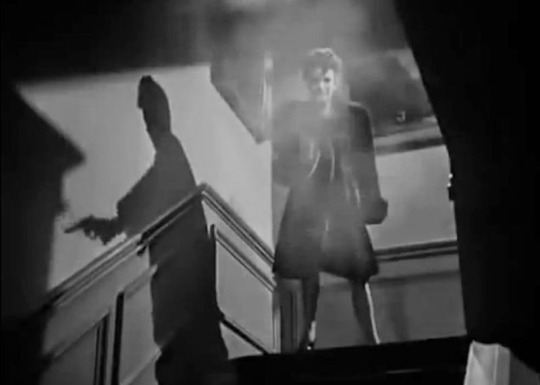
Kathleen has tipped off the police, who only want to charge him with stealing a taxi cab. Kathleen asks if he can be booked at another time because they have a date at the City Hall - to get married.
End of Story
As a curtain call, Keighley chats with Lucille Ball and Mark Stevens. He congratulates Ball on the success of her stage show, Dream Girl, a play she says she will do again in San Francisco. When Keighley asks how Lucille’s busy schedule and that of her husband Desi Arnaz’s leave any time for a personal life, Ball says that they will be playing in San Francisco at the same time.

In June 1947, Lucille Ball performed at New Jersey’s McCarter Theatre in Dream Girl, a play by Elmer Rice. It also played Brooklyn, Detroit and Boston.

The San Francisco production opened just a week after this radio telecast. As Ball states, Desi Arnaz was also in San Francisco at the time, playing in the Rose Room of the Palace Hotel, a fact that was advertised in the Dream Girl program. During the Los Angeles engagement in January 1948, Ball fell ill and had to withdraw. Although she love performing on stage, her radio career and then television success did not allow her to return to the footlights until 1960.

Lucy notes that like many other busy stars, she owes her good complexion to Lux Soap!
Turning to Mark Stevens, Lucille notes that he will play an FBI man in his next project at Fox, with Keighley as director.
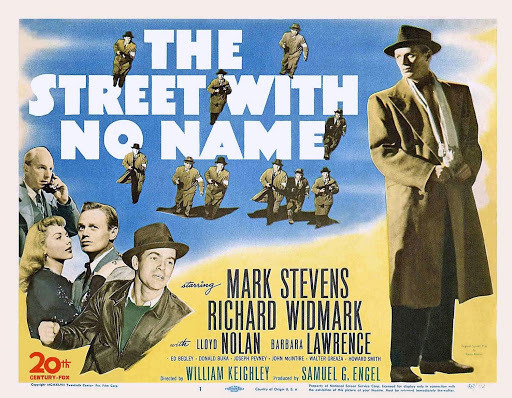
Although the film’s title is not mentioned, they are referring to The Street With No Name, which won’t be released until June 1948. Stevens plays Gene Cordell aka George Manley, a covert FBI agent who infiltrates a ruthless gangster mob. "Lux Radio Theater" broadcast a 60-minute radio adaptation of the movie on January 31, 1949 with Mark Stevens reprising his film role.
Keighley notes that next week “Lux Radio Theatre” will present Jane Wyman and Ronald Reagan in Nobody Lives Forever.

The Warner Brothers picture Nobody Lives Forever was released on November 1, 1946. It originally starred John Garfield and Geraldine Fitzgerald in roles taken on radio by Reagan and Wyman, who were husband and wife at the time. Of course, Reagan left Hollywood for a grander stage, first in California as Governor, then as President of the United States. He bestowed Lucille Ball with The Kennedy Center Honor in 1986.
A public service announcement asks housewives to salvage kitchen fats and turn them in at their local butcher for cash!
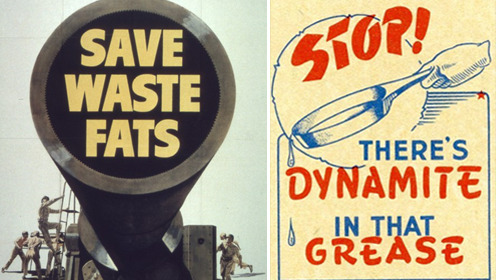
These were used to make supplies for wartime, such as ammunition and weapons.
Announcer Kennedy notes that Mark Stevens appeared through the courtesy of 20th Century Fox, producers of Forever Amber.

Forever Amber is a 1944 romance novel by Kathleen Winsor set in 17th-century England. It was made into a film in 1947 starring Cornel Wilde, who appeared in “The Star Upstairs” (ILL S4;E25). When “Lucy Writes A Novel” (ILL S3;E24), Ethel jokes about finding Lucy’s hidden manuscript and burning it: “We pulled down the kitchen blind and changed the name of your novel to 'Forever Ember.'”
‘DARK’ TRIVIA

In a September 1985 episode of “Remington Steele,” a character played by Stephen Dillane has the name Bradford Galt! The stories, however, are not otherwise connected.
In both the film and the radio show, Fred Foss gives his phone number as CH-elsea 4-43510. However, according to the Manhattan phone book for 1946, there were only CH-elsea 2 and CH-elsea 3 exchanges. Real phone numbers were rarely used in film or television.

When television began to supplant radio, “The Lux Video Theatre” was introduced. It was seen from 1950 to 1959. Initially, the show was a thirty-minute weekly show featuring live stage plays, but when it moved to NBC in August 1954, the show was extended to sixty minutes. As on radio, the programs were then primarily adaptations of motion pictures. The host would introduce each act, and would conduct an interview with the stars at the end of the play. Of the cast of this radio version of The Dark Corner:
William Keighley directed an episode in 1951.
Mark Stevens did an episode in 1955.
Dan O’Herlihy did five episodes.
Joseph Kearns did three episodes.
The character name Ralph Wickett replaced Hardy Cathcart for the radio show. It is likely that they could no longer get legal clearance to use the name Hardy Cathcart, necessitating the change.
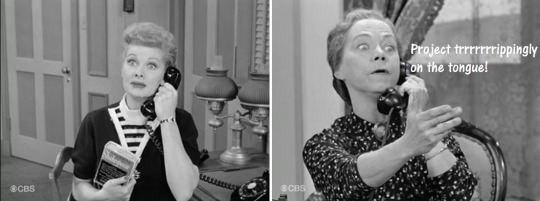
The film featured Ellen Corby as a maid, a role not in the radio drama. Corby went on to be seen as Lucy Ricardo’s high school acting teacher and in several small roles on “The Lucy Show” before her best-loved role of Grandma on “The Waltons.”

The film also features background work by Sam Harris, who did 15 films with Lucille Ball, in addition to multiple episodes of “I Love Lucy” and “The Lucy Show” as well as Harold Miller, who did eight films with Lucy and two episodes of “I Love Lucy”.

The film is available on DVD complete with DVD commentary and original trailer.

#The Dark Corner#Lucille Ball#Mark Stevens#Lux Radio Theatre#Radio#1948#Joseph Kearns#William Keighley#1947
8 notes
·
View notes
Text
Sunset Boulevard: More Than Just The Strip

Several galleries in our hollywoodphotographs.com collection depict sites located on Sunset Boulevard and for good reason: the street tells so many aspects of the Hollywood story - associations with the early film industry, entertainment venues, and key places where residents worked, shopped, and worshipped. Twenty-two miles in length, the winding and heavily trafficked thoroughfare includes portions of a centuries old cattle trail and sections which bridge several subdivisions of Los Angeles as it passes from downtown LA to the Pacific Ocean. The route runs through the neighborhoods of Echo Park, Silverlake, Los Feliz, Hollywood, West Hollywood, Beverly Hills, Holmby Hills, BelAir, Brentwood, and Pacific Palisades. The stretch from Hillhurst Avenue in Los Feliz on the east, to Sierra Drive in West Hollywood, has long been associated with the Golden Age of Hollywood. It’s so iconic, it even has its own movie: Sunset Boulevard, a classic made in 1950, directed by Billy Wilder, starring Gloria Swanson and William Holden.

Many early motion picture entrepreneurs set up shop along Sunset Boulevard’s eastern portion, one such studio survives at 4401 Sunset (now used by Scientology Media). While DW Griffith’s Intolerance set no longer towers over the intersection at Hillhurst Avenue, the Spanish Colonial Revival Vista Theater at 4473 Sunset (1923, Lewis A. Smith) with its delightful Egyptian interior remains. To the west, the first site of Warner Brothers in Hollywood (now known as Sunset Bronson) at 5800 Sunset still operates, as does the Columbia Studios complex (now called Sunset Gower). Across the street at 6121 Sunset, stands CBS Columbia Square (1938, William Lescaze and ET Heitschmidt, International Style), the brainchild of William Paley and epicenter of his West Coast radio empire. Paley built his complex on the site of the very first studio in Hollywood and a plaque commemorating that history still rests in the front courtyard.

Two entertainment venues - the Palladium (6215) and the Earl Carroll Theatre (6230) dominate the blocks east of Vine Street. Both are designated Historic Cultural Monuments (as is CBS) and associated with prominent architects and owners. At 6360, the modernist Cinerama Dome (1963, Welton Becket and Associates), was a slightly later addition to the street that continued the development pattern of restaurants, theater, and retail around Vine Street. The intersection of Sunset and Vine played a particularly prominent role in the radio and music industries from the 1930s through the 1960s.
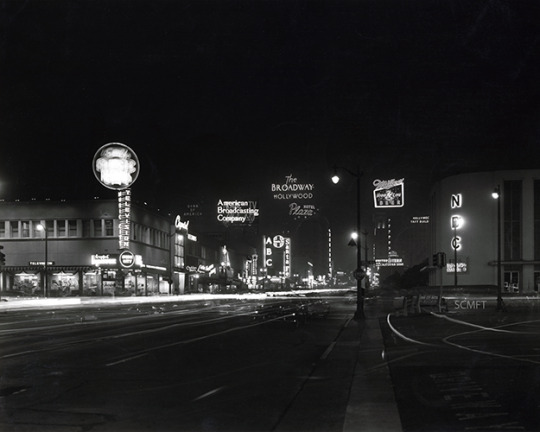
As Sunset crosses Cahuenga, several institutions – the Hollywood Athletic Club (6525, Beaux Arts), Blessed Sacrament Church (6657, Spanish Colonial Revival), Crossroads of the World (6671, Robert Derrah, Streamline Moderne), and the Hollywood Reporter (6715, Hollywood Regency) – are just a few examples of early 20th century styles that made Hollywood famous for its architectural and cultural diversity within the community.

Located at Sunset and Highland, Hollywood High School was founded in 1903; its lovely Streamline campus designed by architects Marsh, Smith, and Powell dates from 1935. One block west, the corner of Sunset and La Brea was once home to the famous Tiny Naylor’s Drive-In. Further west through the historic neighborhoods of Spaulding Square and Sunset Square (designated Historic Preservation Overlay Zones), are the Director’s Guild at 7920, the former locations of Schwab’s Pharmacy at 8024, and the Garden of Allah Hotel at 8150 (soon to be a new development designed by Frank Gehry). The Garden was headquarters for transplanted writers during their stays in Hollywood, including Robert Benchley, Dorothy Parker (of New York Algonquin Hotel fame), and novelist F. Scott Fitzgerald.

The Chateau Marmont at 8221 (1928, Arnold Weitzman, Norman Style), just west of Crescent Heights, is the gateway to the “Sunset Strip”, the most famous/infamous section of the boulevard. Located in the city of West Hollywood, this part of Sunset was, and still is, a major hub of Los Angeles nightlife, known for its trademark array of colorful billboards. The mile and a half stretch running from Harper Avenue passed Sunset Plaza to the boulevard’s western border with Beverly Hills, is densely populated with trendy boutiques, restaurants, nightclubs and venues that have been social gathering spots of the entertainment industry and its fans for over eight decades.
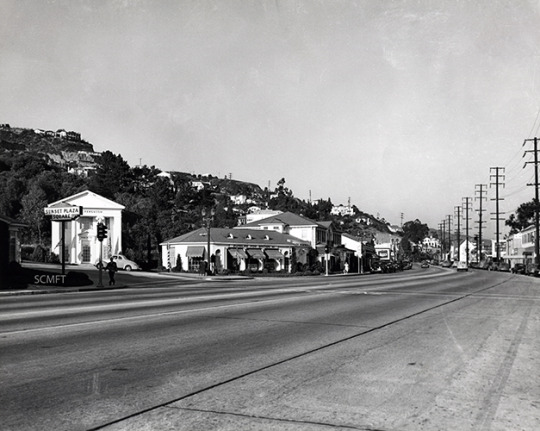
Historically outside of the Los Angeles city limits, in an unincorporated area of the county of Los Angeles, these blocks of Sunset were policed by the less vigilant Sheriff’s Department rather than the heavy hand of the LAPD, thus the area was perceived to be more permissive of public behavior. It was illegal to gamble in the city, but legal in the county. This fostered the building of a wilder concentration of nightlife than Los Angeles proper would tolerate in the 1920s. As a consequence, a number of nightclubs and casinos moved in along The Strip, attracting celebrities and other more liberal-minded locals, as the alcohol continued to flow in back rooms during Prohibition.
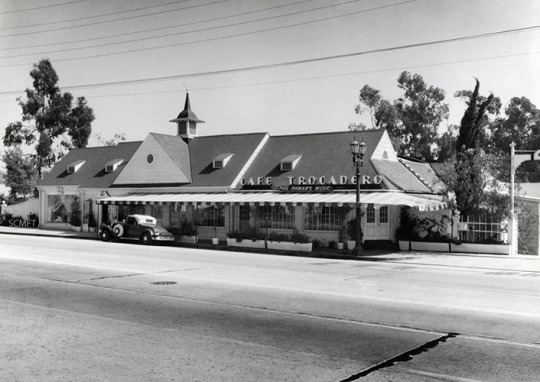
Glamour and glitz especially defined The Strip in the 1930s and 40s, as its renowned restaurants and nightclubs became playgrounds for the rich and famous. Movie legends, power brokers and everyone who was anyone danced at such legendary clubs as Ciro’s (8433), Mocambo (8588), and the Trocadero (8610). Some of its more expensive clubs and restaurants were said to be owned by gangsters like Mickey Cohen, earning the Strip a mention in Raymond Chandler’s Philip Marlowe novel The Little Sister. Most were owned by Hollywood insiders, such as Billy Wilkerson (publisher of the Hollywood Reporter) and director Preston Sturges. The publicity machine of the studios required their stars to be visible to the public, so gossip columnists like Hedda Hopper and Louella Parsons were also regularly in attendance to report on the events and star sightings at these high profile venues.
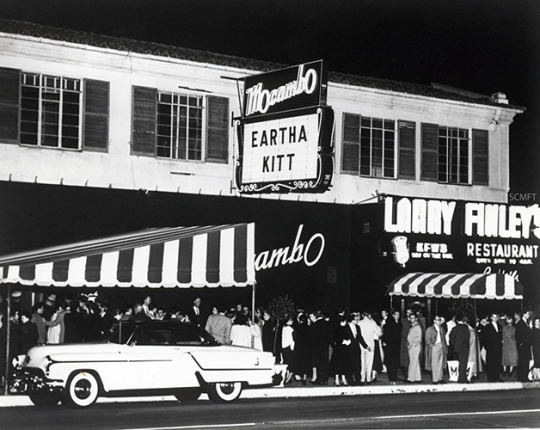
By the early 1960s, The Strip seemingly lost favor with movie people, but the restaurants, bars and clubs continued to attract out of town visitors and locals. In the mid-60s and 70s, the area became a major hang out for the counterculture and rock music scenes, as well as the epicenter of the Sunset Strip curfew riots in the summer of 1966, which inspired the Buffalo Springfield song For What It’s Worth. Go-Go dancers performed nightly at such hotspots as the Whisky-a-Go-Go (8901), while bands such as The Doors, The Byrds, Frank Zappa, Van Halen, Motley Crue, Guns ’n Roses, and Whitesnake all played at the Roxy (9009), Pandora’s Box, London Fog, Rainbow Bar & Grill (9015), and Viper Room (8852).

As The Strip became a haven for musical artists in the 1970s and 80s, the Continental Hyatt House (8358), also referred to as the Riot House (now Andaz), became a second home for touring rock bands such as Led Zeppelin, The Rolling Stones, and The Who. Consequently, the hotel became associated with notoriously debaucherous behavior for a time, many of its most outrageous legends later retold in Hollywood movies and TV shows. The Chateau Marmont (8221) and Sunset Tower (at 8358; Leland Bryant, 1931 Art Deco/Streamline Moderne), also share a long history of housing transplant artists during their stays in Hollywood, serving as film sets, and receiving mentions in literature, music, and pop culture.
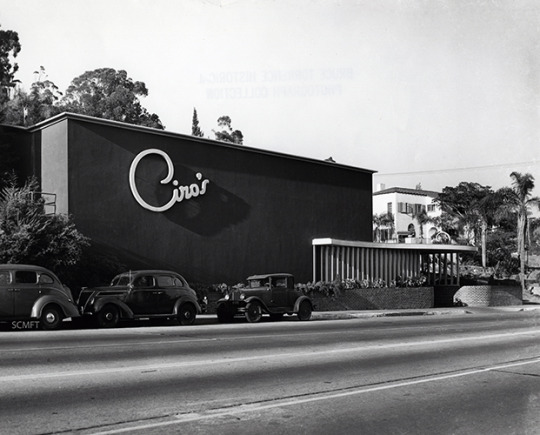
The Comedy Store (8433), the former site of Ciro’s, gave many comics like Jim Carrey, Sam Kinison, David Letterman, and Jay Leno their starts, while bonafide comedians like Richard Pryor, Whoopi Goldberg, Eddie Murphy, Jerry Seinfeld, and Robin Williams would often try out their new acts in front of crowds.

Tales of Sunset’s history and significance are as long as the boulevard itself. We could easily go on. From the early 1900s to present, Sunset Blvd has been one of Hollywood’s favorite destinations to create, work, play, and shop; the variety of buildings and legends clearly reflect that. Regardless of your actual location, you too can take a trip down Sunset Blvd via hollywoodphotographs.com right now! Please enjoy exploring all the galleries we’ve linked to in this post and be sure to stay tuned for even more in-depth stories of other magnificent Hollywood locations soon to follow.
~ Christy McAvoy and Carly Caryn, Historic Hollywood Photographs
#sunset blvd#hollywood#sunset strip#architecture#streetsofla#cityscape#streetscape#west hollywood#los angeles#history#nightlife#celebrities#historic hollywood photographs#hollywood photos
6 notes
·
View notes